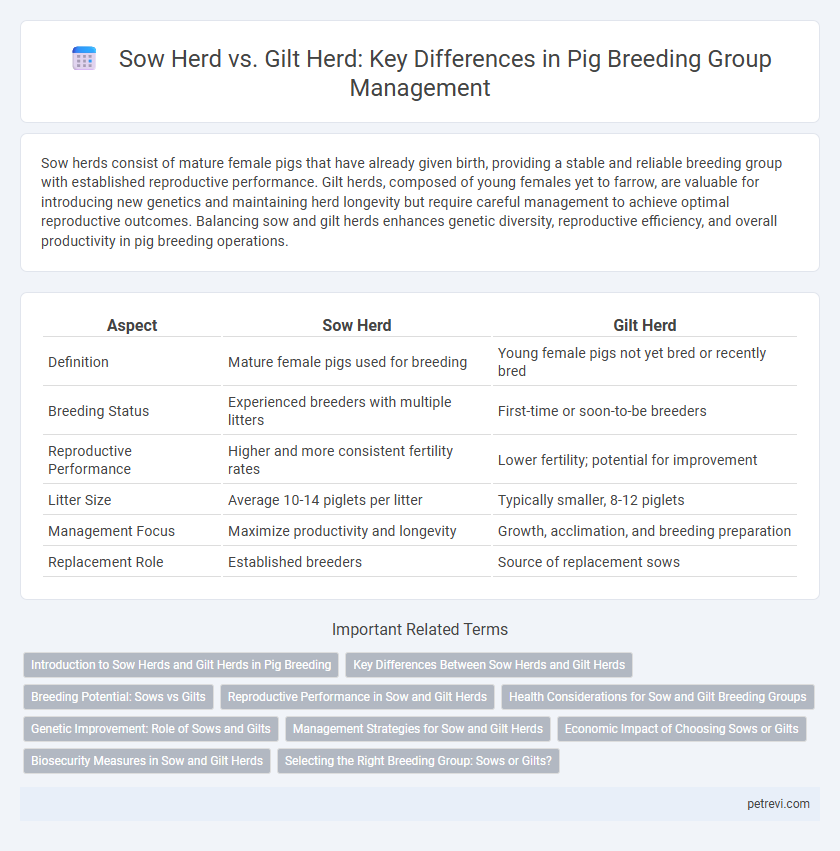Sow herds consist of mature female pigs that have already given birth, providing a stable and reliable breeding group with established reproductive performance. Gilt herds, composed of young females yet to farrow, are valuable for introducing new genetics and maintaining herd longevity but require careful management to achieve optimal reproductive outcomes. Balancing sow and gilt herds enhances genetic diversity, reproductive efficiency, and overall productivity in pig breeding operations.
Table of Comparison
| Aspect | Sow Herd | Gilt Herd |
|---|---|---|
| Definition | Mature female pigs used for breeding | Young female pigs not yet bred or recently bred |
| Breeding Status | Experienced breeders with multiple litters | First-time or soon-to-be breeders |
| Reproductive Performance | Higher and more consistent fertility rates | Lower fertility; potential for improvement |
| Litter Size | Average 10-14 piglets per litter | Typically smaller, 8-12 piglets |
| Management Focus | Maximize productivity and longevity | Growth, acclimation, and breeding preparation |
| Replacement Role | Established breeders | Source of replacement sows |
Introduction to Sow Herds and Gilt Herds in Pig Breeding
Sow herds consist of mature female pigs that have already farrowed, providing a stable foundation for consistent piglet production. Gilt herds comprise young females that have not yet farrowed, representing the future reproductive potential within pig breeding operations. Effective management of both sow and gilt herds ensures sustained productivity and genetic improvement in pig breeding programs.
Key Differences Between Sow Herds and Gilt Herds
Sow herds consist of mature female pigs that have already farrowed, providing proven reproductive performance and established mothering abilities, while gilt herds are composed of young female pigs that have not yet farrowed, serving as future breeding stock. Sow herds typically offer more consistent litter sizes and piglet survival rates compared to gilt herds, which may have variable fertility and require careful management to reach breeding potential. Reproductive efficiency, herd stability, and production predictability distinguish sow herds from gilt herds in pig breeding operations.
Breeding Potential: Sows vs Gilts
Sow herds exhibit higher breeding potential due to their proven reproductive performance and established fertility records, resulting in greater litter size and piglet viability. Gilt herds offer genetic diversity and reproductive longevity but often have lower initial conception rates and smaller first litters compared to sows. Breeding programs optimize productivity by balancing the stability of sow herds with the genetic improvement potential of gilt herds.
Reproductive Performance in Sow and Gilt Herds
Sow herds exhibit higher reproductive performance compared to gilt herds, with sows typically producing larger litter sizes and demonstrating improved farrowing rates due to their physiological maturity and established breeding cycles. Gilt herds, while essential for herd replacement, show lower conception rates and smaller litter sizes as gilts undergo their initial reproductive phases and adapt to breeding conditions. Effective management and nutrition strategies are critical to enhance gilt reproductive efficiency, bridging the performance gap between gilt and sow herds in commercial pig breeding operations.
Health Considerations for Sow and Gilt Breeding Groups
Health considerations in sow and gilt breeding groups focus on disease prevention, immune status, and nutritional needs tailored to reproductive stages. Sow herds usually require monitoring for chronic conditions and reproductive tract infections due to repeated breeding cycles, while gilt herds demand stringent biosecurity to prevent introduction of new pathogens. Maintaining optimal vaccination schedules and stress reduction protocols enhances overall herd immunity and reproductive performance.
Genetic Improvement: Role of Sows and Gilts
Sows contribute significantly to genetic improvement in pig breeding groups due to their proven reproductive performance and established genetic traits, ensuring consistency in offspring quality. Gilts introduce fresh genetic material, enhancing diversity and potential for improved traits such as growth rate and disease resistance. Balancing sow and gilt herds optimizes genetic progress by combining reliable genetic lines with new, innovative traits.
Management Strategies for Sow and Gilt Herds
Effective management strategies for sow and gilt herds involve tailored breeding, nutrition, and health protocols to maximize reproductive performance and longevity. Sow herds require intensive monitoring of parity grouping and replacement rates to sustain productive cycles, while gilt herds focus on selecting high genetic merit and acclimation to breeding environments to ensure successful integration. Implementing structured gilt development programs and optimizing sow culling criteria enhance overall herd productivity and profitability in pig breeding operations.
Economic Impact of Choosing Sows or Gilts
Choosing sows over gilts in pig breeding groups significantly affects economic outcomes due to sows' higher reproductive efficiency and greater litter sizes, which improve overall productivity and reduce replacement costs. Gilts require additional development time, increasing feed and housing expenses before they reach breeding age, impacting short-term profitability. The decision between sow and gilt herds must balance upfront investment with long-term genetic gains and herd stability to optimize economic returns.
Biosecurity Measures in Sow and Gilt Herds
Biosecurity measures in sow and gilt herds prioritize disease prevention by implementing strict isolation protocols, regular health monitoring, and controlled access to breeding facilities. Sow herds typically require enhanced biosecurity due to their established reproductive roles, involving routine vaccinations and stringent sanitation to protect valuable breeding stock. Gilt herds demand focused quarantine procedures and acclimatization periods to prevent pathogen introduction and ensure overall herd health.
Selecting the Right Breeding Group: Sows or Gilts?
Choosing between sow and gilt herds for pig breeding significantly influences herd productivity and genetic progress. Sow herds bring proven reproductive performance and established maternal traits, while gilt herds offer genetic diversity and the potential for genetic advancement due to younger stock. Optimal selection depends on balancing immediate productivity needs with long-term genetic improvement goals, considering factors like reproductive efficiency, health status, and replacement rates.
Sow herd vs Gilt herd for Pig breeding groups Infographic

 petrevi.com
petrevi.com